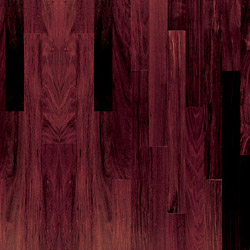Appearance
Color: Can vary from
light yellowish tan with green overtones to almost blackish brown;
exhibits a large range of coloration when freshly milled; darkens over
time to medium to dark brown.
Grain: Fine to medium, straight to very irregular.
Variations Within Species And Grades:
Properties
Hardness/Janka: 3680;
185% harder than Northern Red Oak
Dimensional Stability: Average (8.0; 7% more stable
than red oak).
Durability:
|
|
Workability
Sawing/Machining: Difficult,
especially with hand tools
Sanding: Difficult. This wood is identified as dense
and oily. Scratches are easily seen – each sanding must carefully
remove the scratches from the previous cut, or sanding marks will be
visible in the finish. Suggested Sequence:
First Cut: 7° - 15° Angle wi
Nailing: Standard nailing involves using 2-inch
cleats or staples driven at a 50-degree angle using a pneumatic driver.
An optimal method is to predrill with a 7/16 inch countersink bit and
hand nail every 8 inches on center and every 16 inches on the joist
line
Finishing: Test all products before using them on the
actual floor. Oil-modified finishes may not dry if standard procedures
are followed. Moisture-cure urethane, conversion varnish, or water base
finishes are generally more successful. Alternate method is sealin
Comments: Has been known to cause contact dermatitis.
Cost
Multiplier:
Availability
Readily available.
|





